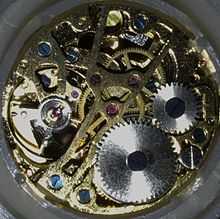Chinese standard movement

The Chinese Standard Movement, also commonly known as the "Tongji" (Chinese: 统机, "unified") movement, is a mechanical watch movement that was developed in the People's Republic of China during its fourth Five-Year Plan in the 1970s. Once possibly the most commonly produced mechanical/automatic watch movement in China, the numbers produced and their quality (at least for a majority of produced movements) have since declined significantly; today the movement lives on typically in simple (even crude) automatic and skeletonized (i.e. using hollowed-out parts and segments such that the inner workings are more visible) variants, usually installed in cheaply produced watches made in China as well.
History
.jpg)
The objective of the process that led to the production of the Chinese Standard Movement was to make a steel-cased, 17-jewel watch that was accessible to the common Chinese worker and thus inexpensive to produce yet still reliable. Conceived at the end of the third Five-Year Plan, blueprints for the movement design were finalized in November 1971,[1] during the first months of the fourth Five-Year Plan.
Though the movement was the predominantly produced watch movement in China until the 1980s, its manufacture was not immune to the quartz crisis of the watch industry that occurred during that decade; changes in economic policy, replacement designs, factory closings, and the re-purposing of a number of Chinese watch-producing facilities (by the 1970s there were at least 30 complete watch manufacturing enterprises in China, but more than a decade later this number would be smaller) would contribute to declines in its manufacture. Furthermore, the return of Hong Kong to China in 1999 (until then, Hong Kong had been producing its own movements, both quartz and mechanical) also reduced the dominance of the Chinese Standard Movement in terms of numbers manufactured.[1]
The movement is frequently seen today in its skeletonized and simple automatic variants in watches whose list prices range between U$10–100. The quality on a majority of movements has declined significantly since its initial manufacture in the 1970s, and in spite of its design (which is considered to be good[1]) it has since earned a reputation for poor quality, mostly due to quality control and manufacturing quality issues of the facilities in China which still produce this movement. However, because of its "standard" nature, low-end brands frequently can and do obtain movements and movement parts from the lowest possible supplier (regardless of quality) with the knowledge that they will fit the cases, hands and dials that they have sourced from elsewhere, ensuring the movement's continued ubiquity.[1]
Today, decades after its initial production, some Chinese watch companies (privatized, like Liaocheng Watch Factory,[2] and state-owned alike) are still developing variants of the movement and making modifications to the original design, which suggests that movements of acceptable quality will continue to be available, at least from a few sources.[1]
Production details and specifications
The movement is manufactured in a number of grades (from high to low) in both automatic and manual-winding or handwinding forms. Initially manufactured exclusively by Chinese companies (i.e. state-controlled watch manufacturers), variants of the Chinese Standard Movement can be found in all grades and both forms, including in a number of watches whose marques are not Chinese but are still manufactured in China.
- Jewel bearings: 17 (minimum; some variants have more than this)
- Power reserve: 40 hours (many lower-quality, mass-produced versions made today may have power reserves of less than 40 hours)
- Beats per hour (bph): 21,600 (or 6 beats per second; many versions may also be 18,000 bph or 5 beats per second)
- Average gain/loss rate: +/- 30 seconds per day (many lower-quality versions made today may have somewhat wider ranges)
References
- ↑ 1.0 1.1 1.2 1.3 1.4 "Chinese Standard Movement.", Chinese Watch Industry Wiki
- ↑ "Shandong Liaocheng Zhong Tai Watch Company.", Chinese Watch Industry Wiki